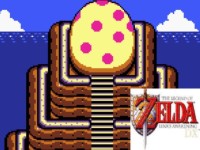April 3, 2014 Operation All The Zeldas! Link’s Awakening
 Considering that every Zelda game until Ocarina of Time is platform/generation defining, Link’s Awakening might get overlooked. Though the Game Boy is the first portable platform, the defining game of the platform is Pokemon or Tetris. Link’s Awakening might not be the biggest game on the Game Boy, but it still deserves a lot of attention. If for nothing else, the story of the game’s creation is worth paying attention to.
Considering that every Zelda game until Ocarina of Time is platform/generation defining, Link’s Awakening might get overlooked. Though the Game Boy is the first portable platform, the defining game of the platform is Pokemon or Tetris. Link’s Awakening might not be the biggest game on the Game Boy, but it still deserves a lot of attention. If for nothing else, the story of the game’s creation is worth paying attention to.
The game began as a side project of Kazuaki Morita. It began as a clone of Zelda, but as he attracted attention, it evolved into an after hours club of developers. They reworked the project into a full-fledged port of A Link To The Past. Once script writer Kensuke Tanabe joined he gave the game its unique story. This guerrilla project got big N’s blessing and became a full-fledged project. The after-hours nature of the project held, this is a Zelda game with no Zelda. There’s not even a Triforce. The game was meant to feel a bit like Twin Peaks according to Yoshiaki Koizumi. There are a bunch of odd cameos from other Nintendo franchises as well, making this probably one of the most unique games in the entire franchise.
If you don’t remember the game, there is an excellent port available for the 3DS of the Gameboy Color Version. (The GBC version has that odd color pallet of the GBC, and a bonus dungeon with lots of color based puzzles.) The game opens with Link waking up in a bed, though this time he’s being tended to after he washed ashore on an island. He is being tended to by Marin, a girl that found him washed ashore after a storm. (The game’s title screen has a cinematic of Link’s shipwreck.) You have your shield, but are missing your trusty sword. A quick walk down to the beach and you’re back in business. You find yourself on Koholint Island. It bears a passing resemblance to Hyrule, but rather than Death Mountain the high mountain has a giant egg.
The game’s central plot revolves around Link’s quest to wake the Windfish. According to a helpful owl, this is the only way he’ll be able to escape the island. To do so he’ll need to get eight instruments, which sends him to eight dungeons. Though you can say that much of the game from here takes the form of the earlier Zelda games, it is different. The mystery behind the island and the Windfish are threaded through your boss battles, and clues you find inside dungeons. This becomes the influence in the rest of the franchise, as the plot becomes more developed.
The more intricate plot isn’t the only element that Link’s Awakening brought to the franchise. An owl that guides Link on his quest makes his first appearance here, though he isn’t nearly as helpful as he’ll become in Ocarina of Time. This is first swap quest in the series, one that lasts a good majority of the game. This feels like encouragement to interact with more of the slightly off-kilter world they’ve created. It’s great that they’ve done so, as this is a wonderfully textured world. You can really feel the roots of Majora’s Mask inherent weirdness in Koholint Island, so it’s worth exploring.
Due to its limited platform, Link’s Awakening might be overlooked for it’s contributions to the series. It’s shoved between two of the most beloved titles in the series, so it gets a little bit of Jan Brady syndrome. The DX version on the 3DS does make this a tad more accessible, and if you missed this game you should grab it. The only real complaint I had was not knowing to load your saves if you die, as beating the game without dying nets you a special ending. We’ll see you next month when we cover the epic Ocarina of Time.
Tags: Operation All The Zeldas
Written by: Michael McConnell
- 1 comment
- Posted under Videogames
Permalink # Meags
said
Meags
said
This is my favorite Zelda title ever. I’ve played it like 6 times.